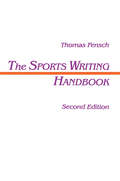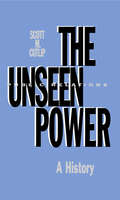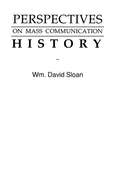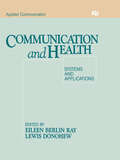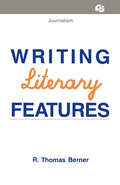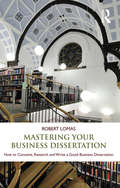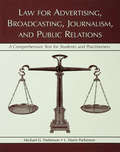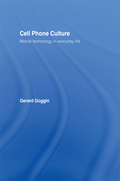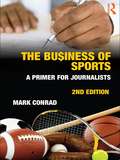- Table View
- List View
The Sports Writing Handbook
by Thomas FenschCompletely revised and updated in a second edition, this volume represents the only book ever written that analyzes sports writing and presents it as "exceptional" writing. Other books discuss sports writers as "beat reporters" in one area of journalism, whereas this book shows aspiring sports writers a myriad of techniques to make their writing stand out. It takes the reader through the entire process of sports writing: observation, interviewing techniques, and various structures of articles; types of "leads;" transitions within an article; types of endings; use of statistics; do's and don'ts of sports writing; and many other style and technique points. This text provides over 100 examples of leads drawn from newspapers and magazines throughout the country, and also offers up-to-date examples of sports jargon from virtually every major and minor sport played in the U.S.
The Unseen Power: A History
by Scott M. CutlipBased largely on primary sources, this book presents the first detailed history of public relations from 1900 through the 1960s. The author utilized the personal papers of John Price Jones, Ivy L. Lee, Harry Bruno, William Baldwin III, John W. Hill, Earl Newsom as well as extensive interviews -- conducted by the author himself -- with Pendleton Dudley, T.J. Ross, Edward L. Bernays, Harry Bruno, William Baldwin, and more. Consequently, the book provides practitioners, scholars, and students with a realistic inside view of the way public relations has developed and been practiced in the United States since its beginnings in mid-1900. For example, the book tells how: * President Roosevelt's reforms of the Square Deal brought the first publicity agencies to the nation's capital. * Edward L. Bernays, Ivy Lee, and Albert Lasker made it socially acceptable for women to smoke in the 1920s. * William Baldwin III saved the now traditional Macy's Thanksgiving Day parade in its infancy. * Ben Sonnenberg took Pepperidge Farm bread from a small town Connecticut bakery to the nation's supermarket shelves -- and made millions doing it. * Two Atlanta publicists, Edward Clark and Bessie Tyler, took a defunct Atlanta bottle club, the Ku Klux Klan, in 1920 and boomed it into a hate organization of three million members in three years, and made themselves rich in the process. * Earl Newsom failed to turn mighty General Motors around when it was besieged by Ralph Nader and Congressional advocates of auto safety. This book documents the tremendous role public relations practitioners play in our nation's economic, social, and political affairs -- a role that goes generally unseen and unobserved by the average citizen whose life is affected in so many ways by the some 150,000 public relations practitioners.
The Unseen Power: A History
by Scott M. CutlipBased largely on primary sources, this book presents the first detailed history of public relations from 1900 through the 1960s. The author utilized the personal papers of John Price Jones, Ivy L. Lee, Harry Bruno, William Baldwin III, John W. Hill, Earl Newsom as well as extensive interviews -- conducted by the author himself -- with Pendleton Dudley, T.J. Ross, Edward L. Bernays, Harry Bruno, William Baldwin, and more. Consequently, the book provides practitioners, scholars, and students with a realistic inside view of the way public relations has developed and been practiced in the United States since its beginnings in mid-1900. For example, the book tells how: * President Roosevelt's reforms of the Square Deal brought the first publicity agencies to the nation's capital. * Edward L. Bernays, Ivy Lee, and Albert Lasker made it socially acceptable for women to smoke in the 1920s. * William Baldwin III saved the now traditional Macy's Thanksgiving Day parade in its infancy. * Ben Sonnenberg took Pepperidge Farm bread from a small town Connecticut bakery to the nation's supermarket shelves -- and made millions doing it. * Two Atlanta publicists, Edward Clark and Bessie Tyler, took a defunct Atlanta bottle club, the Ku Klux Klan, in 1920 and boomed it into a hate organization of three million members in three years, and made themselves rich in the process. * Earl Newsom failed to turn mighty General Motors around when it was besieged by Ralph Nader and Congressional advocates of auto safety. This book documents the tremendous role public relations practitioners play in our nation's economic, social, and political affairs -- a role that goes generally unseen and unobserved by the average citizen whose life is affected in so many ways by the some 150,000 public relations practitioners.
Total Propaganda: From Mass Culture To Popular Culture
by Alex S. EdelsteinBLURB FOR TOTAL PROP MAILER................ Total Propaganda moves the study of propaganda out of the exclusive realm of world politics into the more inclusive study of popular culture, media, and politics. All the participatory functioning elements of the society are aspects of membership in the popular culture. Thus, the values of popular music, media, politics, debates over social issues, and even international trade become everyday propaganda to which everyone may relate. To emphasize the necessity for new thinking about propaganda, Edelstein creates the concepts of the new propaganda and the old, and he devises a language of "uninyms" to convey their meanings more quickly. "Oldprop" is characteristic of mass cultures and utilizes totalitarian methods of conflict, hegemony, minimization, demonization, and exclusiveness to achieve its goals. By contrast, "newprop" is created by members of the popular culture to allow them to engage in accomodation, enhance the individual, and promote inclusiveness. Shifts in the old and the new propaganda are tracked across social issues such as race, religion, sexuality, gender, gun control, and the environment, as well as in fashion, politics, advertising, sports, media, and politics. Central to the concept of total propaganda is that it is not simply additive; it is the product of new energies that are produced by the fusing of propaganda in such related forums as music, art, advertising, sports and politics. It is these synergies, and their production of new energies, that make total propaganda greater than the sum of its parts. Edelstein concludes that the most important distinction that should be drawn between mass culture and popular culture is its text; i.e., its propaganda. In a popular culture, everyone creates and consumes propaganda; in a mass culture almost everyone consumes it but only a few create it. This formulation offers new ways to discuss power and ideology in media texts. As an example, where once the least informed and the least educated were the most subject to propaganda, now the most informed and most educated often are the first to create propaganda and the first to consume it. FORMER BLURB COPY.......It is widely recognized that the mass media provide us with ample information which we use to construct some sense of the world around us. It is not as widely recognized that consumers of media messages are active in this constructive process, making meanings that are sensible to them in particular life circumstances. The media target a younger, more media savvy generation who are more likely to be participants in the messages than members of any previous generation. This participatory aspect of new media is central to what the author defines as the new propaganda. Although critical and cultural theories are often prohibitive for undergraduate students, the author's formulation offers an accessible way to discuss power and ideology in media texts. Without using the critical discourse, he provides compelling arguments that power and ideology are created and maintained through the active participation of audience members. The conceptualization of the old and new propagandas helps move the study of propaganda out of the realm of world politics into the study of popular culture. The author views all of the participatory functioning of the society as aspects of membership in a more embracing popular culture. This point of view recognizes that the mass media are extremely important forces in the consumer's construction of reality and that they are no longer exclusive channels for disseminating the messages of the powerful elites. Instead, the media -- particularly the new media -- are accessible to and used frequently by less powerful members of society -- children, ethnic minorities, and marginal members of society -- to create realities that more satisfactorily fulfill their needs. NEW BLURB COPY FOR GENERAL CATALOGS... Total Propaganda is a fresh answer to the question of the inclusiveness of the popular culture. It demonstrates how the values of popular
Total Propaganda: From Mass Culture To Popular Culture
by Alex S. EdelsteinBLURB FOR TOTAL PROP MAILER................ Total Propaganda moves the study of propaganda out of the exclusive realm of world politics into the more inclusive study of popular culture, media, and politics. All the participatory functioning elements of the society are aspects of membership in the popular culture. Thus, the values of popular music, media, politics, debates over social issues, and even international trade become everyday propaganda to which everyone may relate. To emphasize the necessity for new thinking about propaganda, Edelstein creates the concepts of the new propaganda and the old, and he devises a language of "uninyms" to convey their meanings more quickly. "Oldprop" is characteristic of mass cultures and utilizes totalitarian methods of conflict, hegemony, minimization, demonization, and exclusiveness to achieve its goals. By contrast, "newprop" is created by members of the popular culture to allow them to engage in accomodation, enhance the individual, and promote inclusiveness. Shifts in the old and the new propaganda are tracked across social issues such as race, religion, sexuality, gender, gun control, and the environment, as well as in fashion, politics, advertising, sports, media, and politics. Central to the concept of total propaganda is that it is not simply additive; it is the product of new energies that are produced by the fusing of propaganda in such related forums as music, art, advertising, sports and politics. It is these synergies, and their production of new energies, that make total propaganda greater than the sum of its parts. Edelstein concludes that the most important distinction that should be drawn between mass culture and popular culture is its text; i.e., its propaganda. In a popular culture, everyone creates and consumes propaganda; in a mass culture almost everyone consumes it but only a few create it. This formulation offers new ways to discuss power and ideology in media texts. As an example, where once the least informed and the least educated were the most subject to propaganda, now the most informed and most educated often are the first to create propaganda and the first to consume it. FORMER BLURB COPY.......It is widely recognized that the mass media provide us with ample information which we use to construct some sense of the world around us. It is not as widely recognized that consumers of media messages are active in this constructive process, making meanings that are sensible to them in particular life circumstances. The media target a younger, more media savvy generation who are more likely to be participants in the messages than members of any previous generation. This participatory aspect of new media is central to what the author defines as the new propaganda. Although critical and cultural theories are often prohibitive for undergraduate students, the author's formulation offers an accessible way to discuss power and ideology in media texts. Without using the critical discourse, he provides compelling arguments that power and ideology are created and maintained through the active participation of audience members. The conceptualization of the old and new propagandas helps move the study of propaganda out of the realm of world politics into the study of popular culture. The author views all of the participatory functioning of the society as aspects of membership in a more embracing popular culture. This point of view recognizes that the mass media are extremely important forces in the consumer's construction of reality and that they are no longer exclusive channels for disseminating the messages of the powerful elites. Instead, the media -- particularly the new media -- are accessible to and used frequently by less powerful members of society -- children, ethnic minorities, and marginal members of society -- to create realities that more satisfactorily fulfill their needs. NEW BLURB COPY FOR GENERAL CATALOGS... Total Propaganda is a fresh answer to the question of the inclusiveness of the popular culture. It demonstrates how the values of popular
Perspectives on Mass Communication History
by Wm. David SloanThis unique volume is based on the philosophy that the teaching of history should emphasize critical thinking and attempt to involve the student intellectually, rather than simply provide names, dates, and places to memorize. The book approaches history not as a cut-and-dried recitation of a collection of facts but as multifaceted discipline. In examining the various perspectives historians have provided, the author brings a vitality to the study of history that students normally do not gain. The text is comprised of 24 historiographical essays, each of which discusses the major interpretations of a significant topic in mass communication history. Students are challenged to evaluate each approach critically and to develop their own explanations. As a textbook designed specifically for use in graduate level communication history courses, it should serve as a stimulating pedagogical tool.
Perspectives on Mass Communication History
by Wm. David SloanThis unique volume is based on the philosophy that the teaching of history should emphasize critical thinking and attempt to involve the student intellectually, rather than simply provide names, dates, and places to memorize. The book approaches history not as a cut-and-dried recitation of a collection of facts but as multifaceted discipline. In examining the various perspectives historians have provided, the author brings a vitality to the study of history that students normally do not gain. The text is comprised of 24 historiographical essays, each of which discusses the major interpretations of a significant topic in mass communication history. Students are challenged to evaluate each approach critically and to develop their own explanations. As a textbook designed specifically for use in graduate level communication history courses, it should serve as a stimulating pedagogical tool.
Communication and Health: Systems and Applications (Routledge Communication Series)
by Eileen Berlin Ray Lewis DonohewThis volume examines this rapidly growing and changing field by applying a unified framework that integrates both interpersonal and mass communication investigations into theoretical and applied issues. Using a systems perspective as the organizational framework, relevant issues in the communication of health care, ranging from micro to macro levels, are discussed. The contributors recognize communication as a major factor affecting health today and therefore go beyond examinations of health communication as simply a dissemination of information regarding diseases, diagnoses, and treatments to show it as a much larger and more complex field with applications to all levels and forms of communication. Communication and Health has as its three main objecties: * providing a comprehensive, detailed, and up to-date picture of health communication * applying an integrated, logical structure to the field * making a clear, strong statement regarding the state of health communication and examining its future prospects The contributors address such issues as provider-patient communication, health care teams, health care organizations, public health campaigns, and health education, and then discuss the factors that affect the processing of health information. Also included are examinations of changes in communication use within interpersonal, small group, and organizational health care contexts as well as the use of mass media and other sources for public health campaigns and for raising public awareness of health issues on a day-to-day basis. Communication and Health fills a void in current literature on this field by serving as both a reference for professionals and researchers and as a textbook for advanced undergraduate and graduate level students in a multitude of courses.
Writing Literary Features
by R. Thomas BernerFirst Published in 1988. Routledge is an imprint of Taylor & Francis, an informa company.
Writing Literary Features
by R. Thomas BernerFirst Published in 1988. Routledge is an imprint of Taylor & Francis, an informa company.
Communication of Politics: 8th Inte
by Bruce I NewmanLearn how political marketing and public relations affect the electoral process! Communication of Politics: Cross-Cultural Theory Building in the Practice of Public Relations and Political Marketing examines how communication and marketing experts influence politics. The book reviews the state of the art in political communication management and marketing through a cross-cultural integration of research and theoretical approaches. An international panel of authors presents a comparative assessment of the impact of candidate and party appeals on the electorate, examines case studies from elections in the United States and Europe, and offers innovative models of voter behavior in the United States, Poland, and Slovenia. Communication of Politics provides valuable insights into the merger of political marketing and public relations. The book examines the cause and effect of the increasing role of communications professionals in the political process and documents the relationship between politicians and communications professionals working in electoral committees, political parties, governments, government agencies, consultancies, and polling agencies. Topics addressed by the international panel of scholars and practitioners include: a critical assessment of strategies used in the 2000 United States Presidential election branding as a means of establishing party values and winning support the expanding roles of polls, focus groups and Internet-based research on elections the relationship between foreign affairs/diplomacy and media/public relations Quangos (Quasi-Autonomous Non-Governmental Organizations) and much more! Communication of Politics: Cross-Cultural Theory Building in the Practice of Public Relations and Political Marketing examines the innovative-and sometimes controversial-uses of contemporary electoral marketing. The book is an essential resource for academics, journalists, and political practitioners, including campaign managers, charity fundraisers, public service managers, party-policy-makers-even candidates.
Mass Media, An Aging Population, and the Baby Boomers (Routledge Communication Series)
by Jeremy H. Lipschultz Michael L. HiltAs the oldest members of the baby boomer generation head into their retirement years, this demographic shift is having a substantial influence on uses of mass media, as well as the images portrayed in these media. Mass Media, An Aging Population, and the Baby Boomers provides a comprehensive examination of the relationship between media and aging issues, addressing mass media theory and practice as it relates to older Americans.Reviewing current research on communication and gerontology, authors Michael Hilt and Jeremy Lipschultz focus on aging baby boomers and their experiences with television, radio, print media, entertainment, advertising and public relations, along with the Internet and new media. They draw from studies about health and sexuality to understand views of aging, and present a view of older people as important players in the political process. Hilt and Lipschultz conclude the volume by addressing trends and making predictions related to baby boomers and mass media.Providing a timely and insightful examination of the linkage between mass media and aging issues, this volume will prove a valuable resource for scholars and students in media and gerontology. It is intended for use in coursework addressing such topics as mass communication and society, media and aging, media and public opinion, sociology, and social gerontology.
Statistical Deception at Work
by John MauroWritten to reveal statistical deceptions often thrust upon unsuspecting journalists, this book views the use of numbers from a public perspective. Illustrating how the statistical naivete of journalists often nourishes quantitative misinformation, the author's intent is to make journalists more critical appraisers of numerical data so that in reporting them they do not deceive the public. The book frequently uses actual reported examples of misused statistical data reported by mass media and describes how journalists can avoid being taken in by them. Because reports of survey findings seldom give sufficient detail of methods on the actual questions asked, this book elaborates on questions reporters should ask about methodology and how to detect biased questions before reporting the findings to the public. As such, it may be looked upon as an "elements of style" for reporting statistics.
Statistical Deception at Work
by John MauroWritten to reveal statistical deceptions often thrust upon unsuspecting journalists, this book views the use of numbers from a public perspective. Illustrating how the statistical naivete of journalists often nourishes quantitative misinformation, the author's intent is to make journalists more critical appraisers of numerical data so that in reporting them they do not deceive the public. The book frequently uses actual reported examples of misused statistical data reported by mass media and describes how journalists can avoid being taken in by them. Because reports of survey findings seldom give sufficient detail of methods on the actual questions asked, this book elaborates on questions reporters should ask about methodology and how to detect biased questions before reporting the findings to the public. As such, it may be looked upon as an "elements of style" for reporting statistics.
Measuring Psychological Responses To Media Messages
by Annie LangCharacterized by its multi-level interdisciplinary character, communication has become a variable field -- one in which the level of analysis varies. This has had important ramifications for the study of communication because, to some extent, the questions one asks are determined by the methods one has available to answer them. As a result, communication research is characterized by the plethora of both qualitative and quantitative approaches used by its practitioners. These include survey and experimental methods, and content, historical, and rhetorical analyses. A variety of tools has been developed in cognitive psychology and psychophysiology which attempts to measure "thinking" without asking people how they do it. This book is devoted to exploring how these methods might be used to further knowledge about the process of communication. The methods chosen have all been used extensively in cognitive and experimental psychology. Each chapter in this book is designed to describe the history of the method being introduced, the theory behind it, how to go about using it, and how it has already been used to study some area of communication. The methods introduced here vary widely in terms of the amount of equipment and training needed to use them. Some require only theoretical knowledge and a paper and pencil; others require more elaborate hardware and software for implementation. These methods also vary widely in terms of what sorts of variables they can be used to measure. Some of them adapt quite readily to traditional communication variables like persuasion, attitude change, and knowledge; others are more applicable to process type variables such as attention, arousal, involvement, encoding, and retrieval.
Measuring Psychological Responses To Media Messages
by Annie LangCharacterized by its multi-level interdisciplinary character, communication has become a variable field -- one in which the level of analysis varies. This has had important ramifications for the study of communication because, to some extent, the questions one asks are determined by the methods one has available to answer them. As a result, communication research is characterized by the plethora of both qualitative and quantitative approaches used by its practitioners. These include survey and experimental methods, and content, historical, and rhetorical analyses. A variety of tools has been developed in cognitive psychology and psychophysiology which attempts to measure "thinking" without asking people how they do it. This book is devoted to exploring how these methods might be used to further knowledge about the process of communication. The methods chosen have all been used extensively in cognitive and experimental psychology. Each chapter in this book is designed to describe the history of the method being introduced, the theory behind it, how to go about using it, and how it has already been used to study some area of communication. The methods introduced here vary widely in terms of the amount of equipment and training needed to use them. Some require only theoretical knowledge and a paper and pencil; others require more elaborate hardware and software for implementation. These methods also vary widely in terms of what sorts of variables they can be used to measure. Some of them adapt quite readily to traditional communication variables like persuasion, attitude change, and knowledge; others are more applicable to process type variables such as attention, arousal, involvement, encoding, and retrieval.
Corporate Public Relations: A New Historical Perspective
by Marvin N. OlaskyThis volume presents a historical and objective overview of the field of public relations in the past century. It discusses some of the landmark cases in public relations, critiques the philosophies of innovators such as Ivy Lee and Edward Bernays, and explores how corporate public relations has affected economic and political trends. The author concludes by offering long-term alternatives for the future of public relations valuable to both practitioners and corporate executives.
Corporate Public Relations: A New Historical Perspective
by Marvin N. OlaskyThis volume presents a historical and objective overview of the field of public relations in the past century. It discusses some of the landmark cases in public relations, critiques the philosophies of innovators such as Ivy Lee and Edward Bernays, and explores how corporate public relations has affected economic and political trends. The author concludes by offering long-term alternatives for the future of public relations valuable to both practitioners and corporate executives.
Mastering Your Business Dissertation: How to Conceive, Research and Write a Good Business Dissertation
by Robert LomasThe ability to write to a high standard is a key skill that is often overlooked in the business world. This short book from an international, best-selling author offers a practical guide to conceiving, researching and writing a business or management dissertation. Robert Lomas offers an inspirational treatise that will awaken the quest for knowledge among his readership. The book helps business students to frame their research questions in a more helpful manner in order to achieve their research aims and write in a clear and top scoring way. Topics covered include collecting and measuring data, using business statistics, planning research projects and the real mechanics of writing a dissertation. Masters students across business and management will benefit enormously from reading this book, not just in adding serious value to their dissertations, but also helping to improve their writing skills throughout their business careers. This book includes a foreword by Mark Booth.
Applied Public Relations: Cases in Stakeholder Management (Routledge Communication Series)
by Kathy Brittain Richardson Marcie HintonWith its practical orientation and scope, Applied Public Relations is the ideal text for any public relations case studies or public relations management course that places an emphasis on stakeholder groups. Through the presentation of current cases covering a wide variety of industries, locations, and settings, Kathy Richardson and Marcie Hinton examine how real organizations develop and maintain their relationships, offering valuable insights into business and organizational management practices. The book’s organization of case studies allows instructors to use the text in several ways: instructors can focus on specific stakeholders by using the chapters presented; they can focus on particular issues, such as labor relations or crisis management by selecting cases from within several chapters; or they can select cases that contrast campaigns with ongoing programs or managerial behaviors. A focus on ethics and social responsibility underlies the book, and students are challenged to assess the effectiveness of the practices outlined and understand the ethical implications of those choices. This Third Edition features: 25 new and current domestic and international case studies specifically chosen for their relevancy and relatability to students New "Professional Insights" commentaries where practitioners respond to a set of questions relating to their work Increased emphasis on ethics and social responsibility Fully enhanced companion website that is connected with the text, including a test bank and PowerPoint presentations for instructors, and chapter-specific discussion questions and additional readings for students
Law for Advertising, Broadcasting, Journalism, and Public Relations: Law for Advertising, Broadcasting, Journalism, and Public Relations
by Michael G. Parkinson L. Marie ParkinsonThis exceptional new text offers an up-to-date and integrated approach to communication law. Written by two practicing attorneys with extensive experience teaching the communication law course, Law for Advertising, Broadcasting, Journalism, and Public Relations covers the areas of communication law essential and most relevant for readers throughout the communication curriculum. Its integrated approach will serve students and practitioners in advertising and public relations as well as those in journalism and electronic media.Providing background to help readers understand legal concepts, this comprehensive communication law text includes an introduction to the legal system; covers legal procedures, structures, and jurisdictions; discusses the First Amendment and electronic media regulations; and considers issues of access. Additional material includes: *intellectual property law; *employment and agency law, with explanations of how these laws create obligations for mass communication professionals and their employees; *commercial communication laws; and *special laws and regulations that impact reporters, public relations practitioners, and advertisers who deal with stock sales.Special features of this text include:*Magic Words and Phrases--defining legal terms;*Cases--illustrating key points in each chapter;*Practice Notes--highlighting points of particular interest to professional media practices;*Instructions on finding and briefing cases, with a sample brief; and*Examples of legal documents and jury instructions.This text is intended as an introduction to communication law for students and practitioners in mass communication, journalism, advertising, broadcasting, telecommunications, and public relations.
Law for Advertising, Broadcasting, Journalism, and Public Relations: Law for Advertising, Broadcasting, Journalism, and Public Relations
by Michael G. Parkinson L. Marie ParkinsonThis exceptional new text offers an up-to-date and integrated approach to communication law. Written by two practicing attorneys with extensive experience teaching the communication law course, Law for Advertising, Broadcasting, Journalism, and Public Relations covers the areas of communication law essential and most relevant for readers throughout the communication curriculum. Its integrated approach will serve students and practitioners in advertising and public relations as well as those in journalism and electronic media.Providing background to help readers understand legal concepts, this comprehensive communication law text includes an introduction to the legal system; covers legal procedures, structures, and jurisdictions; discusses the First Amendment and electronic media regulations; and considers issues of access. Additional material includes: *intellectual property law; *employment and agency law, with explanations of how these laws create obligations for mass communication professionals and their employees; *commercial communication laws; and *special laws and regulations that impact reporters, public relations practitioners, and advertisers who deal with stock sales.Special features of this text include:*Magic Words and Phrases--defining legal terms;*Cases--illustrating key points in each chapter;*Practice Notes--highlighting points of particular interest to professional media practices;*Instructions on finding and briefing cases, with a sample brief; and*Examples of legal documents and jury instructions.This text is intended as an introduction to communication law for students and practitioners in mass communication, journalism, advertising, broadcasting, telecommunications, and public relations.
Cell Phone Culture: Mobile Technology in Everyday Life
by Gerard GogginProviding the first comprehensive, accessible, and international introduction to cell phone culture and theory, this book is and clear and sophisticated overview of mobile telecommunications, putting the technology in historical and technical context. Interdisciplinary in its conceptual framework, Cell Phone Culture draws on a wide range of national, regional, and international examples, to carefully explore the new forms of consumption and use of communication and media technology that the phenomenon of mobiles represents. This fascinating biography of an important cultural object: adopts an integrated multiperspective approach considers the mobile phone and its history, production, design, consumption and representation examines the implications in contemporary media convergence such as digital photography an mobile internet. Also reflecting on the challenges and provocations of mobile phone technology and use, this is an absolute must read for any student of media studies, cultural studies or technology.
The Business of Sports: A Primer for Journalists
by Mark ConradThis book explores the business aspect of sports with an orientation to those topics that are most relevant to journalists, providing the foundation for understanding the various parts of the sports business. Moving beyond sports writing, this text offers a distinct perspective on professional, college, and international sports organizations – structure, governance, labor issues, and other business factors within the sports community. Written clearly and compellingly, The Business of Sports includes cases (historical, current, and hypothetical) to illustrate how business concerns play a role in the reporting of sports. New features for the second edition include: updates throughout, including disciplinary policies throughout the major sports leagues expanded discussion of intellectual property issues and merchandising new sections on ethical issues in sports, aimed at journalists. Offering critical insights on the business of sports, this text is a required resource for sports journalists and students in sports journalism.
The Business of Sports: A Primer for Journalists
by Mark ConradThis book explores the business aspect of sports with an orientation to those topics that are most relevant to journalists, providing the foundation for understanding the various parts of the sports business. Moving beyond sports writing, this text offers a distinct perspective on professional, college, and international sports organizations – structure, governance, labor issues, and other business factors within the sports community. Written clearly and compellingly, The Business of Sports includes cases (historical, current, and hypothetical) to illustrate how business concerns play a role in the reporting of sports. New features for the second edition include: updates throughout, including disciplinary policies throughout the major sports leagues expanded discussion of intellectual property issues and merchandising new sections on ethical issues in sports, aimed at journalists. Offering critical insights on the business of sports, this text is a required resource for sports journalists and students in sports journalism.
